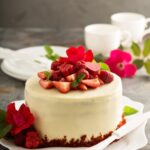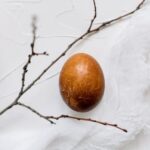Welcome to the world of sugar seashells cake decorating, where imagination and edible art intertwine to create stunningly beautiful cakes. This unique form of cake decoration allows you to elevate your designs with a touch of elegance and whimsy, using lifelike edible seashells. Whether you’re a professional baker or a passionate home decorator, sugar seashells cake decorating is the perfect way to add a magical element to your creations.
When it comes to cake decoration, there are endless possibilities, but sugar seashells truly stand out as a captivating art form. These intricately crafted edible pieces can transform any ordinary cake into an extraordinary masterpiece. From delicate starfish and shimmering shells to majestic conch shells, the variety of sugar seashells available allows you to tailor your designs to suit different themes and occasions.
To embark on your sugar seashells cake decorating journey, you’ll need essential tools and materials. From specialized molds and high-quality sugars to edible paints for adding vibrant colors, this article will guide you on where to find these supplies so that you can bring your vision to life.
With step-by-step instructions on creating lifelike and intricate designs using techniques like isomalt and royal icing, you’ll soon be able to create breathtaking sugar seashells that will impress anyone who lays eyes on your cakes.
Get ready to let your imagination swim as we delve into the enchanting world of sugar seashells cake decorating. In the following sections, we’ll explore different types of sugar seashells that can adorn your cakes, offer tips on achieving realistic colors and painting techniques, inspire you with jaw-dropping design ideas from expert decorators, troubleshoot common dilemmas that may arise during the process, and discuss how to store and preserve these edible works of art for long-lasting beauty.
So grab your apron, gather your tools, and get ready to unlock your creativity. Sugar seashells cake decorating is a delightful exploration that will not only elevate your cake designs but also bring joy to everyone who indulges in your edible masterpieces. Let’s dive in and unleash the magic of sugar seashells.
Tools and Materials for Sugar Seashells Cake Decorating
Essential Tools for Sugar Seashells Cake Decorating
To create stunning sugar seashells for cake decorating, there are several essential tools that you will need. These tools will help you achieve intricate designs and lifelike textures. Here are some must-have tools:
- Silicone Molds: Silicone molds are a crucial tool for creating beautiful sugar seashells. Look for molds that have intricate details and provide a realistic shape. You can find a variety of seashell molds in specialized baking stores or online.
- Isomalt: Isomalt is a type of sugar that is often used to make clear and glass-like sugar seashells. It has a higher melting point than regular sugar, making it ideal for creating delicate seashell designs. Isomalt can be purchased in crystal form or pre-made mixtures.
- Royal Icing: Royal icing is another popular medium for making sugar seashells. It is made by combining egg whites or meringue powder with powdered sugar to create a thick and pliable icing. Royal icing can be piped onto wax paper or directly into the silicone molds to create intricate designs.
- Edible Dusts and Paints: To add color and depth to your sugar seashells, you will need edible dusts and paints. These can be used to highlight the details of the shells and create realistic textures. Edible dusts come in various shades and can be applied with a soft brush, while edible paints allow for more precise detailing.
- Piping Bags and Tips: Piping bags and tips are essential for creating different shapes and textures on your sugar seashells. Look for small round tips for piping fine lines, star-shaped tips for creating textured surfaces, and leaf-shaped tips for adding details like ridges.
Where to Find Specialized Tools and Materials
Finding specialized tools and materials for sugar seashells cake decorating can be a bit challenging, but with some guidance, you can easily source everything you need. Here are some suggestions on where to find these items:
- Baking Supply Stores: Local baking supply stores often carry a variety of silicone molds, isomalt crystals or pre-made mixtures, and other cake decorating tools. Visit your nearest baking supply store and explore their selection.
- Online Retailers: Online retailers offer a wide range of options for sugar seashells cake decorating tools and materials. Websites like Amazon, Etsy, and specialty baking websites have an extensive collection of molds, isomalt crystals, edible dusts, paints, and more.
- Specialty Cake Decorating Stores: Look for specialty cake decorating stores in your area that cater specifically to professional bakers and decorators. These stores often carry a wide range of tools and materials for sugar seashells cake decorating.
By having these essential tools and knowing where to find them, you will be well-equipped to embark on your sugar seashells cake decorating journey. Now that you have the necessary tools ready, it’s time to dive into the step-by-step guide on making sugar seashells from scratch.
Step-by-Step Guide
Creating lifelike and intricate sugar seashells is an essential skill for any cake decorator looking to elevate their designs. Whether you’re aiming for a seaside-themed cake or simply want to add a touch of elegance and whimsy to your creations, knowing how to make sugar seashells from scratch will surely impress your clients and guests. In this step-by-step guide, we will explore different techniques and provide detailed instructions on achieving stunning sugar seashells.
- Isomalt Technique: Isomalt is a type of sugar substitute that is ideal for creating clear and translucent seashells. To use this technique, you will need isomalt granules, a silicone mold, a heat-resistant container, and a heat source such as a stove or microwave. Start by melting the isomalt in the heat-resistant container according to the package instructions.
Once fully melted, carefully pour the liquid into the silicone mold. Allow it to cool and harden before removing the seashells from the mold. - Royal Icing Technique: Royal icing is another popular method for making sugar seashells with more intricate designs and textures. You will need royal icing made from powdered sugar, meringue powder (or egg whites), water, piping tips (such as a small round tip for lines and small star tip for texture), piping bags, and parchment paper. Prepare your royal icing by mixing powdered sugar with meringue powder (or egg whites) and water until you achieve stiff peaks.
Transfer the icing into piping bags fitted with desired tips. On parchment paper, pipe the outline of your seashell shape using a small round tip. Then fill in the interior with lines or dots using another color of icing or texture using a star tip. - Mixing Techniques: To create natural-looking sugar seashells, consider mixing different shades of sugars or edible powders for dimension and realism. Once your seashells have hardened, you can airbrush them or dust them with edible powders to add depth and detail. For example, you can mix white and silver lustre dust to achieve a pearly effect for your seashells.
Mastering the art of making sugar seashells from scratch will unlock endless possibilities for cake decorating. With these techniques and careful attention to detail, you can create beautiful and realistic seashells that will enhance any cake design.
| Technique | Materials |
|---|---|
| Isomalt Technique | Isomalt granules, silicone mold, heat-resistant container, heat source (stove or microwave) |
| Royal Icing Technique | Royal icing (made from powdered sugar, meringue powder or egg whites, water), piping tips (small round tip for lines, small star tip for texture), piping bags, parchment paper |
| Mixing Techniques | Sugars or edible powders of different shades, airbrush or edible powders for dusting |
Types of Sugar Seashells to Embellish Your Cakes
Embellishments are what bring a cake to life and add that extra touch of magic. When it comes to sugar seashells cake decorating, there is an array of options to choose from. From delicate starfish to majestic conch shells, these edible creations can transform a simple cake into a stunning seascape. Let’s explore the different types of sugar seashells that you can use to elevate your cake designs.
One popular choice for sugar seashells is the sand dollar. These flat, round seashells with intricate designs on their surface add a beautiful texture to cakes. They can be easily created using molds and then painted with edible colors to achieve a realistic look. Sand dollars work well as standalone decorations or as part of a larger seashell arrangement.
Another versatile option is the scallop shell. These shells are known for their fan-like shape and distinct ridges. They can be made using various techniques such as isomalt or royal icing, depending on the desired effect. Scallop shells can be arranged in patterns or used individually to create a sense of movement and elegance on your cake.
If you’re looking for something truly eye-catching, consider incorporating conch shells into your design. Conch shells have a unique spiral shape and intricate patterns that make them stand out. They can be crafted using advanced molding techniques and painted in vibrant colors to create a striking visual impact on your cake.
To give your cake design added depth, add smaller details like coral pieces or small seahorses alongside the main sugar seashell decorations. These tiny additions help create a cohesive underwater scene and add whimsy to your overall design.
| Sugar Seashell Type | Description |
|---|---|
| Sand Dollar | Flat, round seashells with intricate designs |
| Scallop Shell | Fan-like shape with distinct ridges |
| Conch Shell | Spiral shape with intricate patterns |
| Coral Pieces | Small, textured pieces resembling underwater coral formations |
| Seahorses | Tiny seahorse shapes to add whimsy to the design |
When selecting sugar seashells for your cake, consider the theme and occasion. Delicate starfish may work well for a beach-themed wedding cake, while vibrant conch shells could be perfect for a tropical birthday celebration. The possibilities are endless, so let your creativity guide you in choosing the right sugar seashells to embellish your cakes.
Color Palette and Painting Techniques for Sugar Seashells
When it comes to sugar seashell cake decorating, choosing the right color palette is essential for creating stunning and realistic designs. Whether you want to achieve a natural look or add a touch of whimsy, understanding color theory and utilizing various painting techniques can make all the difference in bringing your sugar seashells to life.
Selecting the Perfect Color Palette
To create realistic sugar seashells, it’s important to study real seashell colors and patterns. Take inspiration from photographs or actual shells and observe the intricate blend of hues present in each shell. The key is to choose a base color that matches the shell you are trying to replicate and then layer on additional shades to add depth.
Start by selecting a base color that closely resembles the primary color of your chosen shell. For example, if you are creating a sugar conch shell, you may opt for a creamy beige or light pink as the base. Use edible gel colors or powdered food coloring mixed with alcohol to achieve the desired shade.
Once your base color is applied, consider adding highlights and shadows with lighter or darker shades of the same color. Using edible dusts or airbrushing techniques can help add dimensionality and realism. Remember that subtlety is key – avoid overdoing it with heavy-handed applications.
Exploring Painting Techniques
There are several painting techniques you can employ to enhance the appearance of your sugar seashells:
- Dry brushing: Dip a small brush into edible dust or powdered food coloring, then gently wipe most of it off onto a paper towel. Lightly apply the remaining pigment onto raised areas of your seashell design, gradually building up layers for depth.
- Wet-on-wet: This technique involves applying paint while it’s still wet in order to blend colors seamlessly together. It works particularly well when creating gradients or adding details like striping or speckles to your sugar seashells.
- Stippling: Use a small brush or sponge to dab on tiny dots of paint, creating a texture reminiscent of the porous surface often seen on real shells. This technique can add authenticity and make your sugar seashells look lifelike.
Remember to practice patience and precision when painting your sugar seashells. Take your time layering colors, adding details, and blending shades together. With some experimentation and practice, you’ll soon master the art of painting sugar seashells that are sure to impress.
Including these tips and techniques in your sugar seashell cake decorating can elevate your designs and make them truly remarkable. The careful selection of color palettes and the use of various painting techniques are essential in creating realistic edible seashells that will add an extra wow factor to any cake. So get ready to dive into the world of color and create captivating decorations for your next masterpiece.
Adorning Cakes with Sugar Seashells
When it comes to adorning cakes with sugar seashells, the possibilities are truly endless. With a variety of shapes, sizes, and designs available, you can create stunning edible art that will leave everyone in awe. In this section, we will explore some design inspiration to help you take your sugar seashell cake decorating skills to the next level.
One popular design idea is the beach-themed cake. By incorporating sugar seashells into the design, you can create a whimsical and tropical feel that is perfect for summer parties or beach weddings.
Consider using a combination of different shells such as delicate starfish, scallop shells, and intricate conch shells to add depth and texture to your cake. You can arrange them in a cascading pattern on the side of the cake, or even use them as cake toppers for an extra touch of elegance.
For those looking for a more elegant and sophisticated design, consider creating a pearlized effect on your sugar seashells. This can be achieved by using pearlized edible paints or dusts to give your shells a beautiful iridescent sheen. The pearlescent look adds a touch of luxury and glamour to any cake design, making it perfect for weddings or formal events.
If you want to add a bit of whimsy and fun to your cake designs, why not try creating a mermaid-inspired cake? Use larger sugar seashells to create scales on the sides of the cake, and top it off with a fondant mermaid tail for an adorable finishing touch. This design is sure to be a hit at children’s birthday parties or under-the-sea themed celebrations.
Remember that the key to successful sugar seashell cake decorating lies in attention to detail and creativity. Experiment with different combinations of shells, colors, and arrangements to find what works best for your desired design. Whether you choose to create an oceanic masterpiece or something more simple and elegant, sugar seashells are a versatile and eye-catching addition to any cake.
Troubleshooting Common Sugar Seashell Dilemmas
Creating sugar seashells for cake decorating can be a delightful and rewarding process. However, like any art form, it comes with its fair share of challenges. In this section, we will address common dilemmas that may arise when making sugar seashells and provide expert tips and tricks to help you overcome them.
- Air Bubbles: One of the most common issues when working with sugar seashells is the presence of air bubbles. These pesky bubbles can ruin the smooth surface of your creations. To minimize air bubbles, make sure to tap your mold on a sturdy surface after pouring in the melted sugar or isomalt mixture.
This helps release any trapped air pockets. You can also use a toothpick or a small brush to carefully push out any remaining bubbles before the mixture sets. - Breakage: Fragile sugar seashells are susceptible to breakage, especially during the unmolding process or when handling them. To prevent breakage, ensure that your molds are properly prepared by lightly greasing them or using non-stick cooking spray. Additionally, let your sugar shells cool completely before attempting to remove them from the mold.
- Discoloration: Sugar seashells can sometimes develop a yellowish tint during and after the drying process, which can affect their overall appearance. To avoid discoloration, use high-quality ingredients specifically made for creating edible decorations. Opt for clear isomalt instead of regular white granulated sugar as it tends to have less color distortion. Additionally, store finished sugar seashells in an airtight container away from direct sunlight and humidity to maintain their pristine appearance.
By addressing these common dilemmas proactively with the right techniques and knowledge, you can achieve flawless results in your sugar seashell cake decorating endeavors.
Remember to approach each challenge as an opportunity to learn and improve your skills. Troubleshooting can be frustrating at times, but with patience and practice, you’ll soon become adept at creating stunning sugar seashells for your cake designs.
For more in-depth guidance and troubleshooting tips, refer to reputable cake decorating books, online tutorials, or seek advice from experienced decorators in dedicated forums or social media groups. With dedication and determination, you’ll conquer any obstacles that come your way and elevate your sugar seashell cake decorating game to new heights.
Edible Art
Creating sugar seashells for cake decorating is a delightful and artistic endeavor. However, once you have crafted these intricate confections, it’s important to understand how to properly store and preserve them to maintain their beauty and integrity. In this section, we will explore the shelf life of sugar seashells and provide expert tips on ensuring their longevity.
The shelf life of sugar seashells can vary depending on the materials used and the storage conditions. Isomalt sugar seashells tend to have a longer shelf life compared to those made with royal icing.
Isomalt is a type of sugar substitute that is resistant to humidity, making it a more durable option for long-lasting decorations. On the other hand, royal icing can be more prone to moisture absorption, which may cause the shells to become soft or disintegrate over time.
To properly store your sugar seashells, it’s crucial to keep them in a cool and dry environment. Moisture is the enemy when it comes to preserving these delicate creations. Avoid exposing them to direct sunlight or extreme temperatures as this can lead to discoloration or melting. It’s recommended to store them in an airtight container with desiccant packs or silica gel packets added for further protection against humidity.
Additionally, consider placing a layer of tissue paper or parchment paper between each shell in the storage container to prevent any potential damage or breakage during transport or movement. By following these guidelines, you can extend the lifespan of your sugar seashells and ensure they are ready whenever you need them for future cake decorating projects.
Understanding how long your sugar seashells will last allows you to plan ahead and incorporate them into your designs at the right time. As a general rule of thumb, it’s best not to make your sugar seashells too far in advance unless you are confident in their storage conditions. Creating them closer to the date of decorating will help maintain their visual appeal and structural integrity.
Conclusion
In conclusion, sugar seashells cake decorating offers a magical and elegant way to elevate your cake designs. Throughout this article, we have explored the various tools, materials, techniques, and design ideas to create stunning sugar seashells that add a touch of whimsy to any cake.
By following the step-by-step guide on making sugar seashells from scratch, you can achieve lifelike and intricate designs using isomalt and royal icing. The types of sugar seashells available are vast, ranging from delicate starfish to majestic conch shells, allowing you to choose the perfect embellishments for different cake themes and occasions.
The color palette and painting techniques play a crucial role in creating realistic sugar seashells. Selecting the right colors and exploring different painting techniques will add depth and detail to your creations, making them truly eye-catching.
Throughout this journey into sugar seashells cake decorating, we have seen jaw-dropping cake designs that incorporate these edible beauties. By breaking down the design elements used in these cakes, you can learn how to achieve similar results and let your imagination swim with this captivating edible art form.
Remember to troubleshoot common issues such as air bubbles or breakage using expert tips and tricks. Properly storing and preserving your sugar seashells will ensure their long-lasting beauty.
To conclude, let us embrace the joy and versatility of sugar seashell cake decorating. Unleashing your creativity with this art form is sure to impress your guests and make any occasion truly special. So go ahead, explore, experiment, and let your imagination dive into the world of sugar seashells cake decorating.
Frequently Asked Questions
How to make edible seashells for a cake?
To make edible seashells for a cake, you will need some fondant or gum paste, which are materials commonly used in cake decorating. Start by rolling out the fondant into a thin sheet and using seashell-shaped cookie cutters to cut out your desired shapes. If you don’t have seashell-shaped cookie cutters, you can also shape the fondant by hand to resemble seashells.
Once you have your shapes, use edible food coloring or dust with pearl or metallic luster dusts to add color and shine to your seashells. You can also add texture by using a veining tool or toothpick to create lines and indentations on the shells. Let the fondant or gum paste shells dry completely before placing them on your cake.
How to make seashells for cake decorations?
Making seashells for cake decorations is a creative and fun process. One option is to use modeling chocolate or candy melts in various colors such as white, brown, and pastel shades commonly found in seashells. Melt the chocolate or candy melts according to package instructions and pour them into seashell molds that can be found at baking supply stores or online. Once they’ve hardened, pop the shells out of the molds and give them some additional touches like brushing them with metallic luster dusts for added realism.
Another option is to use royal icing to pipe out shell shapes onto parchment paper and let them dry before gently removing them from the paper. Add details such as stripes or spots using food coloring gels mixed with a small amount of water. Just remember to allow these decorations enough time to harden before placing them on your cake.
Can you put real seashells on a cake?
While real seashells can be beautiful natural elements for home decor purposes, it is not recommended to put real seashells directly on a cake as decoration due to possible health concerns. Most commercially sold seashells are not meant for direct consumption as they may have been exposed to pollutants or contain harmful bacteria. Plus, seashells are hard and can pose a choking hazard if accidentally bitten into by someone consuming the cake.
However, you can still use real seashells as inspiration for creating edible or non-edible decorations that resemble seashells. From fondant to modeling chocolate or other icing mediums, there are numerous ways to craft your own seashell decorations that are safe and suitable for adding an oceanic touch to your cake.

Welcome to our cake decorating blog! My name is Destiny Flores, and I am the proud owner of a cake decorating business named Cake Karma. Our mission is to provide delicious, beautiful cakes for all occasions. We specialize in creating custom cakes that are tailored specifically to each customer’s individual needs and tastes.





